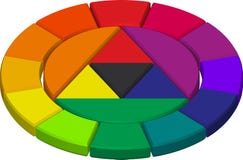
Green is composed of blue and yellow so the colour that hasn’t entered its composition is red, therefore making red its complimentary colour. Since a secondary colour is composed of two colours, here’s the logic behind it. So how can you tell what is a colour’s complimenting opposite?Įasy, but you need your secondary colours.

For example, if you you have orange hair and you want to go blonde as an example, the colour technician will mix in a little concentrated blue pigment into the hair colour in order to cut the orange. Hairdressers (colour technicians rather) use this trick all the time. Here’s the interesting part, we just said that when they are placed alongside each other they compliment one another but what happens when mixed together? Well guess what, they NEUTRALIZE each other. Perfect example being: the red Christmas ornament which will appear all the more red once placed on the green Christmas tree. In the Chromatic Circle the “complementary colours” are pairs of colours that are of opposite hue.īecause they oppose each other, creating contrast, once placed alongside one another, they compliment the opposing colour – hence the name “complimentary colour”. These colours are the direct result of the mix between (in equal parts again) of one primary colour and one secondary colour.Ĭopper or golden yellow: mix of yellow and orange. Orange, which is composed of the red and the yellow.Īnd finally outside the secondary colours of the circle, you will find the “tertiary colours” (yes tertiary is a word, i double checked.) Purple, which is composed of the blue and the red. Green, which is composed of the blue and the green. These colours are the result of an equal mix of two primary colours. Right outside the triangle of the three primary colours you will find the “secondary colours”: green, orange and purple. (I know i’m repeating myself but bare with me, this is the important stuff)

These are the purest of colours – pure because they have not gone through any mixes. The centre of this circle is composed of our three “primary colours”. The better you understand this theory, the better the outcome. We are no longer talking about coloured radiations of light but rather colours as a substance, such as paints for example.įor a Makeup Artist, the comprehension of this theory is KEY in order to create simple mixtures. The Chromatic circle of colours is a theory based on the mixture of colours.


 0 kommentar(er)
0 kommentar(er)
